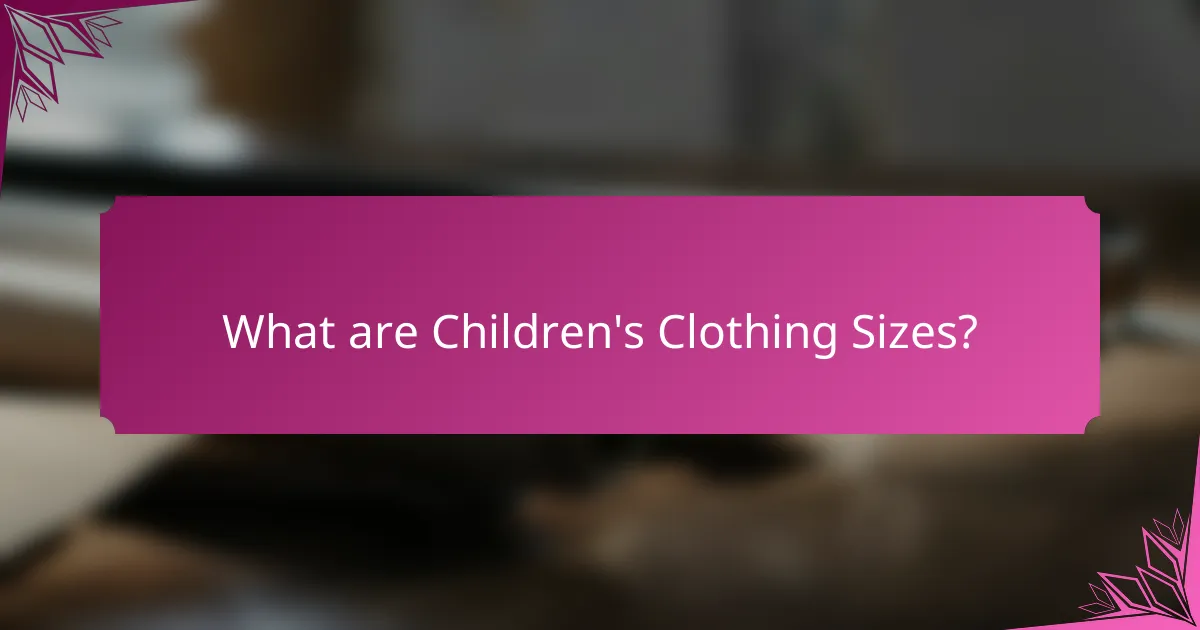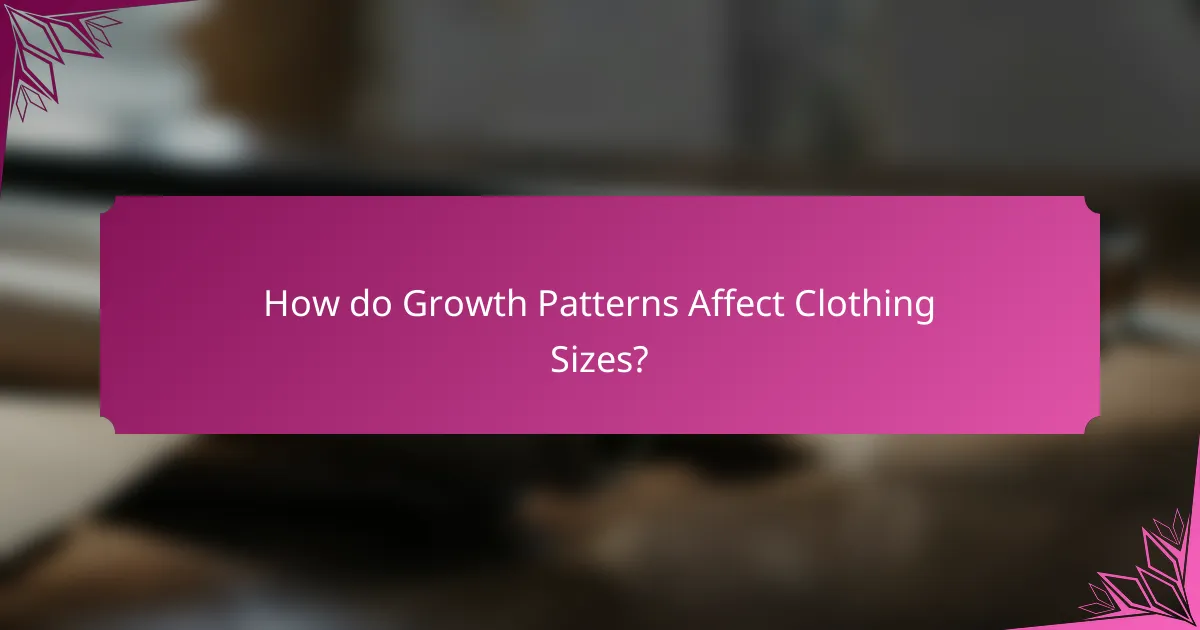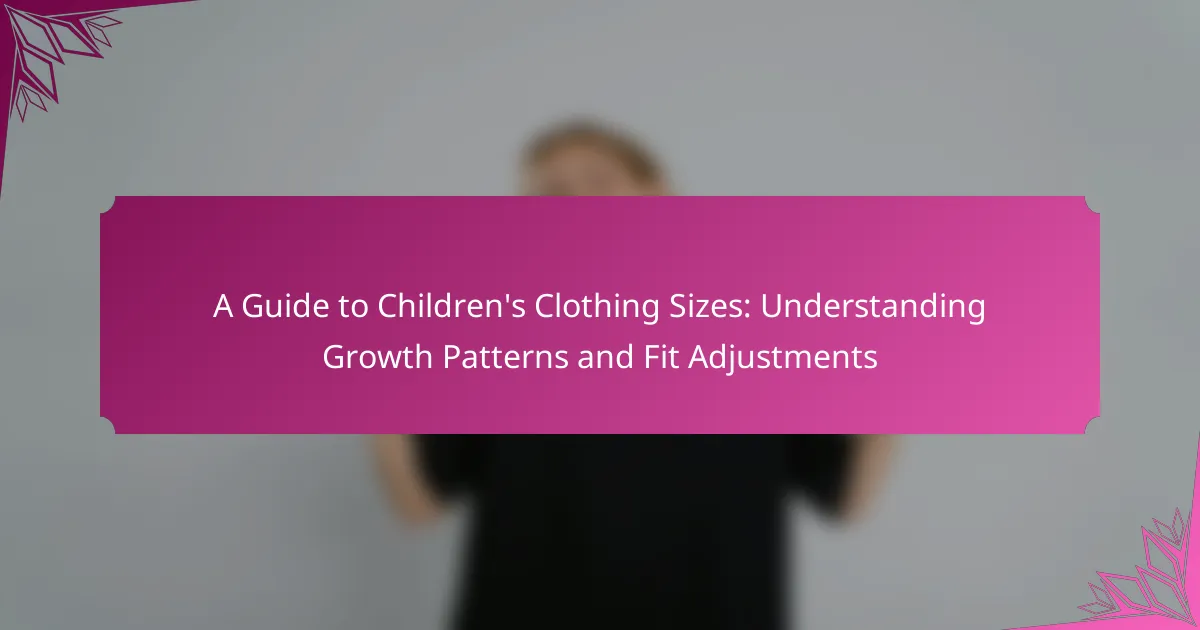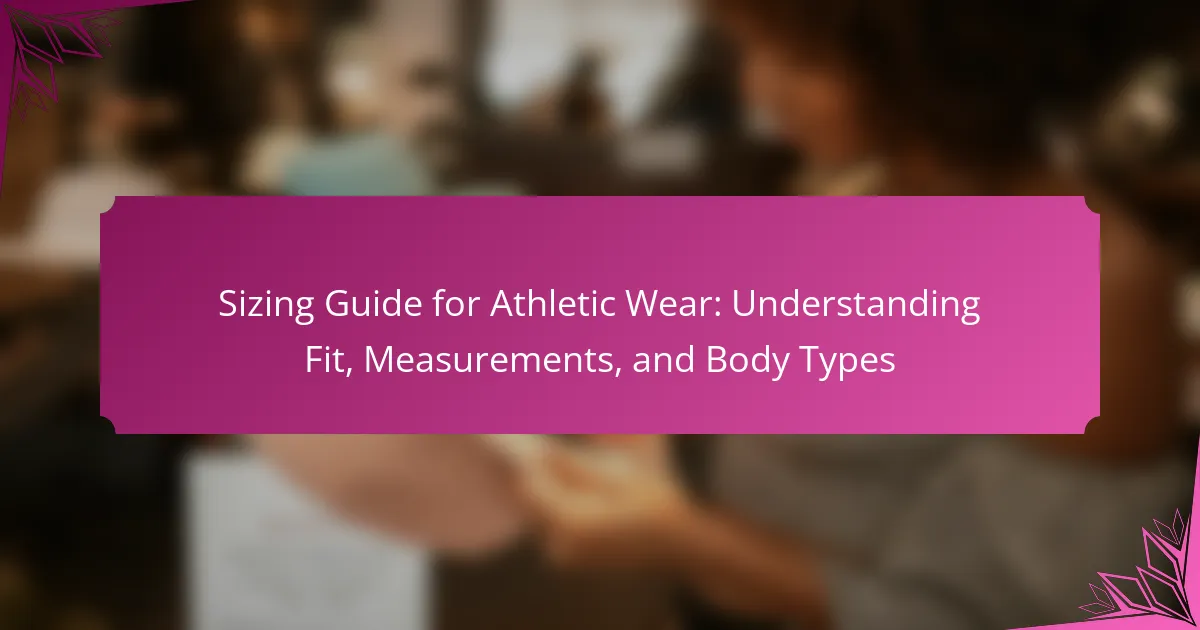Children’s clothing sizes are standardized measurements designed to fit garments for children, ranging from newborn to size 20 and encompassing various age groups and body types. Size categories include infant (0-24 months), toddler (2T-5T), and children’s sizes (4-16), each corresponding to specific age ranges and average height and weight measurements. Growth patterns significantly impact clothing sizes, as children experience rapid changes in body proportions throughout different developmental stages. To ensure proper fit, adjustments such as adjustable waistbands, elastic features, and layering options are recommended, alongside the use of accurate size charts based on current measurements. Understanding these factors is essential for achieving comfort and mobility in children’s clothing.

What are Children’s Clothing Sizes?
Children’s clothing sizes refer to standardized measurements used to fit garments to children. These sizes typically range from newborn to size 20, accommodating various ages and body types. Common size categories include infant (0-24 months), toddler (2T-5T), and children’s sizes (4-16). Each category corresponds to specific age ranges and average measurements for height and weight. For instance, a size 4 generally fits children aged 4 years, with average height around 40 inches. Size charts provided by brands help identify the best fit based on these measurements. Accurate sizing is crucial for comfort and mobility in children’s clothing.
How are children’s clothing sizes categorized?
Children’s clothing sizes are categorized primarily by age, height, and weight. Size labels typically include designations such as newborn, infant, toddler, and youth. Each category corresponds to specific age ranges, usually in months or years. For example, sizes may range from 0-3 months for infants to 2T for toddlers. Height and weight measurements help ensure a better fit. Retailers often provide size charts to guide parents in selecting appropriate sizes. These charts align with standard growth patterns observed in children. Additionally, some brands may offer unique sizing systems that account for different body shapes.
What are the common size labels used for children’s clothing?
Common size labels for children’s clothing include sizes such as newborn, infant, toddler, and various age ranges. Newborn sizes typically fit babies up to 7-8 pounds. Infant sizes are usually categorized as 0-3 months, 3-6 months, and 6-12 months. Toddler sizes often range from 2T to 5T. Additionally, children’s sizes can be labeled by age, such as 4, 5, 6, etc. These labels help parents select appropriate clothing based on their child’s growth and development stages. The labels are standardized across many brands, making it easier for consumers to find the right fit.
How do size charts vary by brand and region?
Size charts vary by brand and region due to differing measurement standards and target demographics. Each brand may have its own sizing system based on design philosophy and customer feedback. For instance, a brand in the United States may use different dimensions compared to a European brand. Additionally, regional cultural factors influence size preferences and body shapes. Research indicates that children’s growth patterns differ globally, affecting how sizes are categorized. A study by the International Journal of Clothing Science and Technology found significant variations in children’s body measurements across regions. This leads to inconsistencies in size charts, necessitating careful comparison when purchasing clothing.
Why is understanding children’s clothing sizes important?
Understanding children’s clothing sizes is important to ensure a proper fit. A correct fit enhances comfort and mobility for children. It also supports their growth and development. When clothing fits well, it allows for ease of movement during play and daily activities. Poorly fitting clothes can cause discomfort and restrict movement. Additionally, understanding sizes helps parents make informed purchasing decisions. It reduces the likelihood of returns and exchanges. Accurate sizing can also promote positive self-esteem in children. Children are more likely to feel confident in clothing that fits well.
How does proper sizing affect children’s comfort and mobility?
Proper sizing directly influences children’s comfort and mobility. When clothing fits correctly, it allows for unrestricted movement. This is essential for active play and physical activities. Ill-fitting clothes can lead to discomfort, restricting movement and causing distractions. For example, tight clothing may hinder a child’s ability to run or jump effectively. Conversely, overly loose clothing can pose tripping hazards. According to a study published in the Journal of Pediatric Health Care, properly sized clothing enhances children’s physical engagement in activities. Thus, accurate sizing is crucial for promoting both comfort and mobility in children.
What role does accurate sizing play in children’s growth and development?
Accurate sizing is crucial for children’s growth and development. Properly fitting clothing supports physical activity and comfort. When children wear the right size, they can move freely and engage in play. This encourages healthy muscle development and coordination. Conversely, ill-fitting clothes can restrict movement and lead to frustration. Research indicates that clothing that fits well can positively impact children’s self-esteem. According to a study published in the Journal of Pediatric Health Care, children in well-fitted clothing reported higher confidence levels. Thus, accurate sizing plays a significant role in fostering both physical and emotional development in children.
What factors influence children’s clothing sizes?
Children’s clothing sizes are influenced by several factors. These include age, height, weight, and body shape. Age is a primary determinant, as children grow at different rates during various developmental stages. Height directly correlates with size, as taller children typically require larger clothing. Weight also plays a crucial role, as heavier children may need wider or longer garments. Body shape influences fit, as some children may have broader shoulders or longer torsos. Additionally, genetics can affect growth patterns, leading to variations in size among children of the same age. Environmental factors, such as nutrition and physical activity, can also impact growth and, consequently, clothing sizes.
How do age, height, and weight determine clothing sizes?
Age, height, and weight significantly influence clothing sizes. Age helps to categorize children into size groups based on typical growth patterns. Height measures the length of the body, which is crucial for determining the fit of garments. Weight indicates body mass, affecting how clothing drapes and fits around the torso and limbs.
Clothing manufacturers often use standardized size charts that correlate these factors. For instance, a child who is taller for their age may require larger sizes than peers of the same age. Similarly, weight can necessitate adjustments in size to ensure comfort and mobility.
Research shows that children’s growth follows specific percentiles based on age, height, and weight. The CDC growth charts provide a reference for these percentiles, guiding parents and retailers in selecting appropriate sizes. This alignment ensures that children wear clothing that accommodates their unique body dimensions effectively.
What are the implications of different body types on clothing fit?
Different body types significantly affect clothing fit. Each body type has unique proportions that influence how garments sit on the body. For instance, a pear-shaped body may require wider hips and a smaller waist in clothing. Conversely, an apple-shaped body often needs more room in the midsection.
Children’s clothing sizes often do not account for these variations, leading to improper fit. Studies indicate that children with varying body types may experience discomfort in standard sizes. This discomfort can result from tightness or looseness in critical areas like the shoulders and waist.
Additionally, the growth patterns of children necessitate adjustments in sizing. Research shows that children’s body proportions change as they grow, impacting fit. Brands that consider these differences typically offer a range of sizes tailored to specific body shapes. This approach enhances comfort and mobility for children, allowing for better wearability.

How do Growth Patterns Affect Clothing Sizes?
Growth patterns significantly influence clothing sizes. As children grow, their body proportions change, affecting fit. For example, infants grow rapidly in the first year, leading to frequent size changes. Toddlers may experience growth spurts that alter waist and length measurements. School-aged children often see changes in shoulder width and chest size. Pre-teens and teens may undergo significant height increases, impacting overall size categories. These growth phases necessitate regular size assessments for proper clothing fit. Research indicates that children’s growth rates vary by age and gender, affecting size recommendations. Accurate sizing is crucial for comfort and mobility during these developmental stages.
What are the typical growth patterns in children?
Children typically experience growth spurts during specific developmental stages. Growth patterns are generally rapid in infancy, slowing down in early childhood. From birth to age two, children can grow about 10 inches in their first year and about 5 inches in the second year. During preschool years, growth averages about 2 to 3 inches per year.
In middle childhood, growth rates stabilize at around 2 inches per year until puberty. Puberty triggers another growth spurt, often starting between ages 9 and 14 for girls and between ages 10 and 16 for boys. During this period, children can grow 3 to 4 inches per year.
After puberty, growth rates decline significantly, with most children reaching their [censured] height by age 18. These patterns are supported by growth charts developed by the World Health Organization, which track height and weight percentiles for children.
How does growth spurts impact clothing size selections?
Growth spurts significantly influence clothing size selections for children. During these periods, children can experience rapid increases in height and weight. This can lead to a need for larger clothing sizes in a short timeframe. Parents often find that previously fitting clothes become too tight or short.
Research shows that children can grow several inches in just a few months during a growth spurt. For example, the average child may grow 2 to 3 inches taller in a single year, necessitating size adjustments. This rapid growth can result in frequent purchases of new clothing to accommodate changing sizes.
Additionally, children’s body proportions may change during growth spurts, affecting fit. As a result, selecting clothing that allows for some flexibility in size can be beneficial. This ensures that clothes can last through multiple growth phases.
What should parents know about seasonal growth changes?
Parents should know that seasonal growth changes in children often occur during spring and summer. During these seasons, children may experience rapid growth spurts. This can lead to a need for new clothing sizes more frequently. Research indicates that children can grow an average of 2 to 4 inches per year. Growth can also vary between boys and girls, with girls typically growing faster during early puberty. Parents should monitor their children’s growth patterns regularly. Keeping track of clothing fit is essential to ensure comfort and mobility. Seasonal changes can also affect children’s activity levels, impacting their growth.
How can parents anticipate future clothing size needs?
Parents can anticipate future clothing size needs by tracking their children’s growth patterns. Regularly measuring their height and weight helps identify growth trends. Children typically grow at predictable rates during certain ages. For example, infants may grow about 1 inch per month in the first six months. After that, growth slows to about 0.5 inches per month until age 2.
From ages 2 to 5, children may grow about 2 to 3 inches each year. Between ages 6 and 12, growth averages about 2 inches annually. Keeping a growth chart can provide a visual reference for these changes. Additionally, considering seasonal clothing needs can aid in planning ahead. Parents should also factor in the brand’s sizing differences, as they can vary significantly.
By understanding these growth patterns and measuring regularly, parents can better predict future clothing size needs.
What signs indicate that a child is outgrowing their clothes?
A child is outgrowing their clothes when they show signs of tightness or discomfort. This includes difficulty in putting on or taking off clothing. Additionally, visible pulling or stretching at seams indicates a poor fit. If the child frequently complains about itchiness or discomfort, it may signal that the clothes are too small. Another sign is when the hem of pants or sleeves sits above the wrist or ankle. Clothing that exposes the midriff when arms are raised is also a clear indicator. Lastly, if the child’s growth spurts are noticeable, it’s time to assess their wardrobe for size adjustments.
How can parents plan for size adjustments during growth phases?
Parents can plan for size adjustments during growth phases by regularly measuring their child’s height and weight. This can help identify when a size change is necessary. Growth spurts typically occur in early childhood and adolescence. Parents should anticipate these changes and purchase clothing one size larger when possible. Keeping an eye on growth charts can provide insights into expected growth patterns. Additionally, choosing adjustable or elastic clothing can accommodate fluctuations in size. Regularly reviewing the fit of clothing ensures comfort and appropriateness. By staying proactive, parents can reduce the frequency of last-minute shopping trips.

What Adjustments Can Be Made for Better Fit?
To achieve a better fit in children’s clothing, several adjustments can be made. First, consider using adjustable waistbands. These allow for flexibility as a child grows. Second, opt for clothing with elastic or drawstring features. Such designs accommodate varying body shapes and sizes. Third, select garments with adjustable straps or cuffs. These can help tailor the fit around arms and legs. Fourth, pay attention to sizing charts. Accurate measurements ensure the right size is chosen based on a child’s current dimensions. Finally, consider layering options. This approach allows for a comfortable fit over time as children grow.
How can clothing be adjusted to fit growing children?
Clothing can be adjusted to fit growing children through various methods. One common approach is using adjustable waistbands. These allow for size modifications as the child grows. Another method is employing elastic materials in clothing, providing flexibility and comfort. Hemming pants or sleeves can also extend the life of garments. Adding extra fabric through tucks or panels offers room for growth. Layering clothing can accommodate size changes while maintaining style. Regularly checking fit ensures timely adjustments. These strategies help maximize the usability of children’s clothing.
What are common alterations parents can make at home?
Parents can make several common alterations to children’s clothing at home. Hemming pants and skirts is a frequent adjustment. This ensures the garment fits properly as children grow. Taking in or letting out seams can adjust the fit around the waist or chest. Parents can also add or remove buttons to modify the size of garments. Shortening sleeves on shirts and jackets is another common alteration. These adjustments help extend the life of clothing as children grow. Repairing small tears or holes can also be considered an alteration, preserving the garment’s usability.
When should parents consider professional tailoring for children’s clothing?
Parents should consider professional tailoring for children’s clothing when the fit is significantly off. This includes situations where the garment is too long or too short in sleeves or pants. Tailoring can also be beneficial if the waist or chest area is too loose or tight. Children’s growth patterns often lead to irregular sizes. Off-the-rack clothing may not accommodate these unique proportions. Professional tailoring ensures comfort and mobility. It also extends the wearability of garments. Tailored clothing can enhance a child’s confidence in their appearance.
What are some tips for choosing the right size for children?
To choose the right size for children, measure their height and weight accurately. Use a measuring tape to determine their height while they stand straight. Weigh them using a reliable scale for accurate weight measurement. Refer to the clothing brand’s size chart, as sizes can vary between brands. Consider the child’s growth rate; choose slightly larger sizes for longevity. Check for adjustable features, like elastic waistbands, for a better fit. Always allow room for movement; clothing should not be too tight. Finally, involve the child in the selection process to ensure comfort and preference.
How can parents effectively measure their children for accurate sizing?
Parents can effectively measure their children for accurate sizing by using a measuring tape to take specific body measurements. First, measure the child’s height while they stand straight against a wall. Next, measure the chest circumference by wrapping the tape around the widest part of the chest. Then, measure the waist circumference at the narrowest point. For pants, measure the inseam from the crotch to the ankle. Finally, measure the hips by wrapping the tape around the widest part of the hips. These measurements should be taken while the child is wearing light clothing for accuracy. It’s recommended to compare these measurements with size charts provided by clothing brands, as sizing can vary. Regular measurement updates are essential due to children’s rapid growth.
What are the best practices for selecting clothing that accommodates growth?
Select clothing with adjustable features to accommodate growth. Look for items with elastic waistbands or adjustable straps. Choose fabrics that are stretchy or have some give. Opt for styles that can be layered for added versatility. Buy slightly larger sizes to allow for growth without compromising fit. Consider clothing with a longer length, as children grow taller. Prioritize quality materials that withstand wear and tear. Regularly assess fit and replace items as necessary to ensure comfort and functionality.
What resources are available for understanding children’s clothing sizes?
Resources for understanding children’s clothing sizes include size charts from manufacturers, online guides, and educational articles. Size charts provide specific measurements for various age groups. Online guides often include tips for measuring a child accurately. Educational articles explain growth patterns and how they affect sizing. Retailers like Target and Gap offer detailed sizing information on their websites. Additionally, parenting blogs frequently share insights and experiences regarding children’s clothing sizes. These resources collectively help parents make informed decisions about sizing.
Where can parents find reliable size charts and guides?
Parents can find reliable size charts and guides on various online retail websites. Major retailers like Target, Walmart, and Amazon provide detailed size charts for children’s clothing. Additionally, brands such as Gap, Old Navy, and H&M offer specific sizing information on their product pages. Many children’s clothing stores also have dedicated size guide sections on their websites. These guides often include measurements for height, weight, and age to help parents choose the right size. Parents can also refer to the American Apparel and Footwear Association for standardized sizing information. Consulting these resources ensures accurate fit and helps accommodate growth patterns in children.
What online tools can assist in determining the right clothing size?
Online tools that assist in determining the right clothing size include size calculators, virtual fitting rooms, and measurement guides. Size calculators require input of measurements like height, weight, and age. They provide recommended sizes based on these inputs. Virtual fitting rooms allow users to upload photos and simulate how clothing fits. These tools often use augmented reality to enhance accuracy. Measurement guides offer step-by-step instructions on how to measure body dimensions. These guides help ensure accurate size selection. Many clothing retailers and fashion websites provide these tools to improve the shopping experience.
Children’s clothing sizes are standardized measurements used to fit garments for various age groups and body types, ranging from newborn to size 20. This guide covers the categorization of sizes based on age, height, and weight, along with common size labels and how they vary by brand and region. Understanding children’s clothing sizes is crucial for ensuring proper fit, comfort, and mobility, which directly impacts growth and development. The article also discusses factors influencing sizes, typical growth patterns, and practical tips for parents to anticipate size needs and make adjustments for better fit. Additionally, it highlights available resources and tools for selecting appropriate clothing sizes for children.




